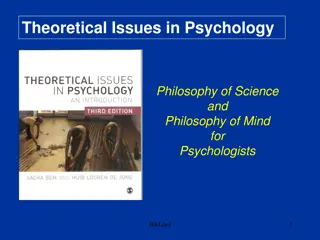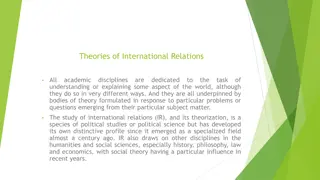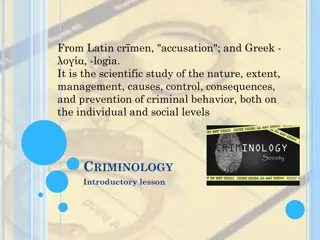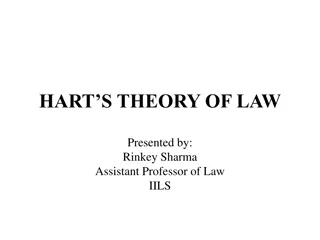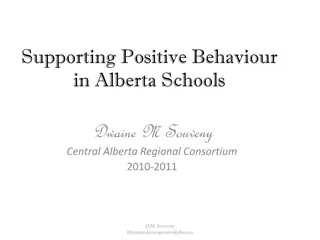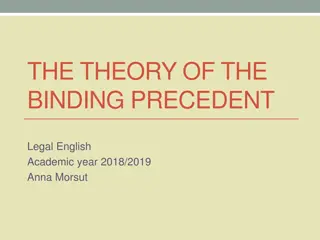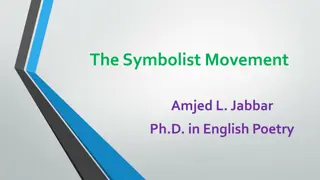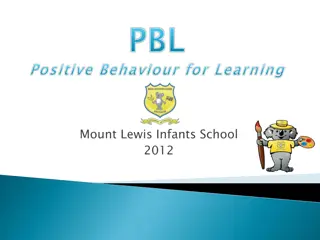Early Positivism and the Positive School of Criminology
The early positivist school of criminology, including figures like Lombroso and Gall, focused on applying scientific methods to understand criminal behavior. Phrenology, atavism, and criminal anthropology were key concepts explored, emphasizing determinism and individual offender characteristics. This approach marked a shift towards understanding criminals in a biological and evolutionary context.
Download Presentation

Please find below an Image/Link to download the presentation.
The content on the website is provided AS IS for your information and personal use only. It may not be sold, licensed, or shared on other websites without obtaining consent from the author.If you encounter any issues during the download, it is possible that the publisher has removed the file from their server.
You are allowed to download the files provided on this website for personal or commercial use, subject to the condition that they are used lawfully. All files are the property of their respective owners.
The content on the website is provided AS IS for your information and personal use only. It may not be sold, licensed, or shared on other websites without obtaining consent from the author.
E N D
Presentation Transcript
POSITIVE SCHOOL OF CRIMINOLOGY PHRENOLOGY, ATAVISM, CRIMINAL ANTHROPOLOGY, SOMATOTYPING, BEHAVIORAL GENETICS, CRIMINAL FAMILIES, ALTRUISM, TWIN STUDIES
EARLY POSITIVISM Lombroso, Galofalo, & Ferri Developed in the nineteenth century Attempt to apply scientific methods to the study of the criminal Rejected the legal definition of crime Emphasized determinism As a result of this orientation, criminology has been dominated by an interest in the individual offender: his personality, body build, intelligence, family background, the neighborhood from which he comes, or the groups to which he belongs (Reference #4)
EARLY POSITIVISM Franz Joseph Gall (19thcentury) PHRENOLOGY The study of cranial contours correlated to areas of the brain that control behavior. Correlated the contours of the skull to segments of the brain; each represented particular faculties and correlated to specific behaviors. (Reference #1)
ATAVISM (1 OF 3) Cesare Lombroso Father of Modern Criminology Biology determines criminal behavior His belief that the criminal man was an evolutionary throwback, or atavistic. The criminal was underdeveloped from an evolutionary standpoint, and therefore, retained primitive animal instincts; he compared them to various aggressive plants and animals Born criminal Criminaloids - weak individuals who are candidates for good or evil according to circumstances, leaving only a small percent of the total criminal class who may be considered organically normal in the fullest sense. (Reference # 1)
ATAVISM (2 OF 3) CRIMINAL FEATURES: SKIN - THE SKIN FREQUENTLY SHOWS SCARS AND (IN THE EPILEPTIC SUBJECT TO SEIZURES) LESIONS ON THE ELBOWS AND TEMPLES. MARKS OF WOUNDS INFLICTED IN QUARRELS AND ATTEMPTED SUICIDE ARE FREQUENT IN HABITUAL CRIMINALS. THE FOREHEAD AND NOSE MUST BE EXAMINED FOR TRACES OF ACNE ROSACEA FREQUENT IN DRUNKARDS WRINKLES - WE HAVE ALREADY SPOKEN OF THE ABUNDANCE AND PRECOCITY OF WRINKLES IN BORN CRIMINALS. THEY ARE ALSO A CHARACTERISTIC OF THE INSANE. EARS - THE EARS OF CRIMINALS AND EPILEPTICS EXHIBIT A NUMBER OF ANOMALIES. THEY ARE SOMETIMES OF ABNORMAL SIZE OR STAND OUT FROM THE FACE. DARWIN'S TUBERCLE, WHICH IS LIKE A POINT TURNED FORWARD WHEN THE HELIX FOLDS OVER, AND TURNED BACKWARD WHEN THE HELIX IS FLAT, IS FREQUENTLY ENCOUNTERED IN THE EARS OF DEGENERATES. THE LOBE IS SUBJECT TO A GREAT MANY ANOMALIES, SOMETIMES IT IS ABSENT ALTOGETHER, IN SOME CASES IT ADHERES TO THE FACE OR IS OF HUGE DIMENSIONS AND SQUARE IN SHAPE. SOMETIMES THE HELIX IS PROLONGED SO AS TO DIVIDE THE CONCHA IN TWO. IDIOTS OFTEN SHOW EXCESSIVE DEVELOPMENT OF THE ANTI-HELIX, WHILE THE HELIX ITSELF IS REDUCED TO A FLATTENED STRIP.
ATAVISM (3 OF 3) NOSE - IN THIEVES THE BASE OF THE NOSE OFTEN SLANTS UPWARDS. EYES - THE EYEBROWS ARE GENERALLY BUSHY IN MURDERERS AND VIOLATORS OF WOMEN. PTOSIS, A SPECIES OF PARALYSIS OF THE UPPER LID, WHICH GIVES THE EYE A HALF-CLOSED APPEARANCE, IS COMMON IN ALL CRIMINALS. CHIN - THIS PART OF THE FACE, WHICH IN EUROPEANS IS GENERALLY PROMINENT, ROUND AND PROPORTIONED TO THE SIZE OF THE FACE, IN DEGENERATES AS IN APES IS FREQUENTLY RECEDING, FLAT, TOO LONG OR TOO SHORT.
CONSTITUTIONAL THEORIES SOMATOTYPING - MORPHOLOGIES Lombroso s stance on personality is essentially an articulation and amplification of constitutional psychology, these are theories that suggest a relation between physique and behavior. (Reference #4)
ENDOMORPH Endomorphic body type: Soft body Underdeveloped muscles Round shaped Over-developed digestive system Associated personality traits: Love of food Tolerant Evenness of emotions Love of comfort Sociable Good humored Relaxed Need for affection (Reference #4)
MESOMORPH Mesomorphic body type: Hard, muscular body Overly mature appearance Rectangular shaped Thick skin Upright posture Associated personality traits: Adventurous Desire for power and dominance Courageous Indifference to what others think or Want Assertive, bold Zest for physical activity Competitive Love of risk and chance (Reference #3)
ECTOMORPH Ectomorphic body type: Thin Flat chest Delicate build Young appearance Tall Lightly muscled Stoop-shouldered Large brain Associated personality traits: Self-conscious Preference for privacy Introverted Inhibited Socially anxious Artistic Mentally intense Emotionally restrained (Reference #3)
CRIMINAL FAMILIES THE JUKE FAMILY KALLIKAK FAMILY
THE JUKE FAMILY Early 1700 s in New York Six illegitimate sisters all criminals One sister: Ada mother of criminals Significant percent of generations of these family members were crime-prone (Reference #5)
THE KALLIKAK FAMILY Feeble-mindedness deficiencies of mental state Martin Kallikak marries a good Quaker woman and have a long line of normal good Quaker children. Martin has an immoral sexual relationship with a woman who is feeble-minded and produced a long line of feeble-minded and criminal-like children. Sexual immorality and alcoholism is prevalent in the family Same Father Two Mothers - Two different types of children. (Reference #6)
BEHAVIORAL GENETICS Genetic Determinism the idea that a person s genetic code allows you to predict the outcome of their life. "Supermale" Syndrome XYY https://www.youtube.com/watch?v=6bsxlnln9ok (Reference #8)
TRUTH OR MYTH? 1. Some individuals are born with the crime gene making them criminals. 2. Genetic factors is deterministic and can cause individuals to become criminal. (Reference #3)
MYTHS MYTHS 1. Identifying the role of genetics in criminal behavior implies that there is a crime gene It is difficult to imagine that a single gene encodes for criminal activity; a more plausible Scenario is that multiple genes interact to create an increased risk for criminal behavior. Moreover, genetic factors are likely to be associated with other behavioral characteristics that are correlated with criminal behavior, such as impulsivity and sensation-seeking behaviors. 2. Attributing crime to genetic factors is deterministic Genes alone do not cause individuals to become criminal. Moreover, a genetic predisposition towards a certain behavior does not mean that an individual is destined to become a criminal. The notion that humans are programmed for certain behaviors fails to acknowledge important environmental factors which are likely to mediate the relationship between genetics and crime. For example, the expression of a genetic liability towards a certain behavior may be minimized or neutralized by positive family rearing conditions. Negative family rearing conditions might trigger a genetic vulnerability. Such an occurrence suggests that genes and the environment interact to either elevate or reduce the risk for certain negative outcomes. (Reference #3)
REFERENCES 1. https://pdfs.semanticscholar.org/0eec/9ef47260b8e503be7024acb7a00bbb9d9282.pdf 2. https://www.mcser.org/journal/index.php/mjss/article/viewfile/684/712 3. https://www.uscourts.gov/sites/default/files/64_2_4_0.pdf 4. https://scholarlycommons.law.northwestern.edu/cgi/viewcontent.cgi?article=4793&context=jclc 5. https://readingroom.law.gsu.edu/cgi/viewcontent.cgi?referer=https://www.google.com/&httpsredir=1&article=1000&context=buckvbell 6. https://readingroom.law.gsu.edu/cgi/viewcontent.cgi?referer=https://www.google.com/&httpsredir=1&article=1006&context=buckvbell 7. https://www.gutenberg.org/files/29895/29895-h/29895-h.htm 8. https://theconversation.com/sci-fi-still-influences-how-society-thinks-about-genes-its-time-we-caught-up-57936 KATIE CALI, INSTRUCTOR OF SOCIOLOGY AND CRIMINAL JUSTICE, AT NORTHSHORE TECHNICAL COMMUNITY COLLEGE. THIS WORK IS LICENSED UNDER THE CREATIVE COMMONS ATTRIBUTION (CC-BY) LICENSE. TO VIEW A COPY OF THE LICENSE, VISIT HTTPS://CREATIVECOMMONS.ORG/LICENSES/BY/4.0/


